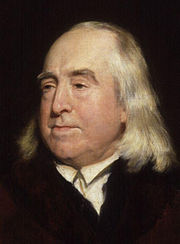As the founder of Utilitarianism, the British Jeremy Bentham is remembered for his integral contributions to the realm of philosophy. Bentham was born in Houndsditch, London on February 15th, 1748 to a wealthy family of Tory party supporters. He was always an engaged, curious child—by the age of three he began studying Latin and by the age of 12, he was sent to The Queen’s College, Oxford. By the time he was a young man, Bentham had applied himself to an extensive study of law and invented endless proposals for legal and social reform.
By 1789 Bentham had written An Introduction to the Principles of Morals and Legislation. The work was a basic expression of the ethics of Utilitarianism and a document that John Stuart Mill would later utilize in his own work on the doctrine.
Essentially, the Utilitarian theory believes that we must look to the consequences of our actions in evaluating their merit and that “the kind of consequence that matters for human happiness is just the achievement of pleasure and avoidance of pain.” Thus, our hedonism can be assessed by considering “how quickly [that pleasure] follows its action and how likely it is to produce collateral benefits and avoid collateral harms.” When all the above is considered, Bentham states, “we arrive at a net value of each action for any human being affected by it.”
Bentham’s original head was ultimately relocated to the bottom of the Auto-Icon. Photo credit: preservedproject.co.uk
Thus, Bentham was a firm advocate for the happiness and health of a community over the needs of the individual because to him a community “is nothing other than the sum of [various] individual human interests.” In that way, Utilitarianism can be seen as a philosophy that tries to cultivate the best way of the life for the greatest number of people.
Founding such a fundamental part of the Utilitarian doctrine became one of Bentham’s greatest life legacies—although equally remarkable are the final wishes and plans Bentham created for his death.
On June 6th, 1832, Bentham died at the age of 84 at his residence in Queen Square Place, London. Before he died, he had been designing his “Auto-Icon,” which displays Bentham’s preserved skeleton to this day. The Auto-Icon is a cabinet containing the philosopher’s skeleton, which is “padded out with hay,” dressed in his clothes, and “surmounted by a wax head.”
Thus, Bentham was a firm advocate for the happiness and health of a community over the needs of the individual because to him a community “is nothing other than the sum of [various] individual human interests.”
Bentham originally intended for his mummified head to be a part of the Auto-Icon, and it was indeed preserved and presented along with the rest of his body for a short while.
But the methods of preservation applied to his head had reportedly distorted the familiarity of his visage; it didn’t take long for Bentham’s actual head to be replaced with a wax reproduction for the Auto-Icon and for Bentham’s actual head to be placed, quite simply, at his feet inside the cabinet.
Bentham’s reasoning for preserving himself in such a manner after death remain unknown—but the Auto-Icon remains on display at the end of the South Cloisters of University College London. The cabinet is reportedly taken out for Council meetings, where Bentham is listed as “present but not voting.”
You May Enjoy Reading:
- An “Intelligent Form of Dying”: Aldous Huxley’s Psychedelic Death
- The Sculpture “Angel of Grief”
- Famadihana: The Malagasy Perspective on Death and Burial

 Forever Visible: Jeremy Bentham’s “Auto-Icon”
Forever Visible: Jeremy Bentham’s “Auto-Icon”



 “Help Me, Helen”
“Help Me, Helen”
 Recovering Cremation Remains After the Los Angeles Fires
Recovering Cremation Remains After the Los Angeles Fires
 “As Tears Go By” by Marianne Faithfull
“As Tears Go By” by Marianne Faithfull














